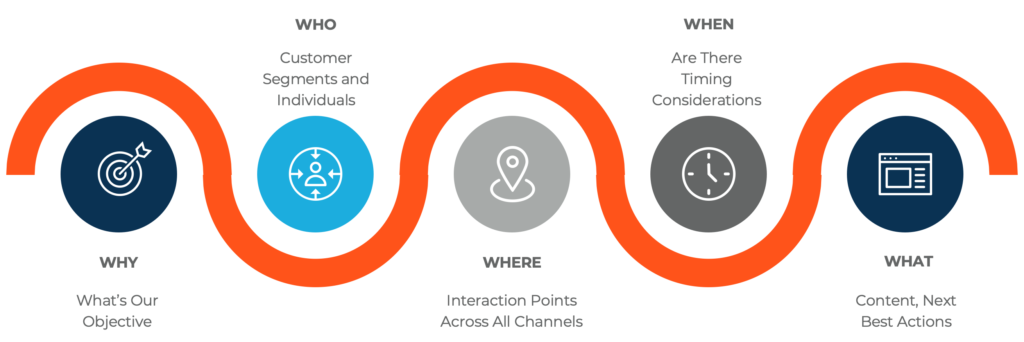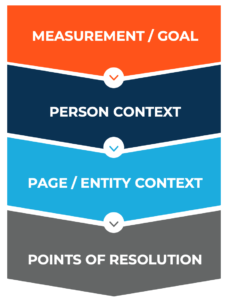Regardless of industry and size, companies everywhere are focused on improving the customer experience. However, that experience is often made complex by taking place across various channels and systems, creating difficulty for organizations wanting to provide the level of personalization customers have grown accustomed to. By following a proven personalization framework and a single technology solution, Interaction Studio from Salesforce, companies can increase their digital maturity more quickly and achieve better business results faster.
1. Set The Foundation For Personalization
Start with the customer’s objective and the business objectives by answering these five questions:
- Why – Why are we embarking on this personalization initiative and what is our business objective?
- Who – Who are the core customer segments or individuals we are focused on?
- Where – Where are the most impactful interaction points across channels?
- When – When will these personalized experiences be implemented and delivered across the customer journey?
- What – What type of content should be delivered and which next-best-actions should be considered?

2. Assets The Touchpoint and Context
After aligning on the overarching objectives and context for personalization, it’s time to narrow in on touchpoints throughout the customer journey and what specifically will be accomplished through personalization.

- Measurement / Goal – Start by understanding the more tactical objectives as they relate to personalization. What are we measuring and how does it ladder up to our broader business objectives?
- Person Context – What do we know about this person relative to their profile? Where are they coming from? What pages or content are they engaging with? What are their preferences? Even when anonymous, every user is creating a profile based on their engagement.
- Entity Context – What is the nature of the page or entity? Where is the customer at this stage of the journey? What is the page experience like and what is it trying to accomplish?
- Points of Resolution – Considering our business objectives, what will help the customer make the right decision? Given what we know about this consumer, what other information might they desire to make the best decision possible?
3. Identify The Appropriate Content
Finally, for each touchpoint, determine the type of personalized content that can be delivered to meet the objective. There are three categories of personalized content that can provide value to customers along their journey:
- RECOGNITION – We recognize something done in the past and acknowledge or display it for recency bias. This may include articles viewed, products browsed, or other types of interactive content.
- WAYPOINTS – We identify collections of content that could be helpful in making the best decision possible. Some examples include blog articles, product comparisons, and general product info.
- CONVERSION PATH – We convert along a linear path, typically collecting categorical information that can further enhance our relationship. Ideas include buying guides or dealer submission data.
By following this three-step framework to personalization, the success rate for an Interaction Studio implementation increases dramatically. Clients have been able to align on business goals faster and the solution implementation time has been streamlined significantly.
A Proven Model
Leveraging this framework, the following three Bold Orange clients have quickly found success with Salesforce’s Interaction Studio.
Global Building Material Manufacturer
Analyzing User Behavior to Increase Email Opt-Ins
- The Challenge – Our client’s website had engaging content and significant traffic, with over 220,000 page views per month. However, visitors were leaving in just under a minute with no information being collected about anonymous user behavior, making it difficult to know what CX website changes to make to gather more registrations and increase conversion rates. Their conversion rates were well under the industry average at less than 1%.
- Our Solution – By leveraging Interaction Studio to begin personalizing elements of the existing website, we were able to avoid making UX changes that are often hard to implement quickly. The solution allowed the client to improve the user registration experience without a full UX overhaul.
- The Results – By tracking user behavior on the website and recognizing key behaviors, Interaction Studio was able to increase email opt-ins by 143%, allowing the brand to initiate an additional conversation channel with a new prospect.
Consumer Goods Manufacturer
Providing Consumer Guidance with Next-Best-Action Offerings
- The Challenge – This leading manufacturer and dealer network has five popular brand names in their portfolio. They were receiving over 300,000 visits per month to their website. Complicating consumer navigation and user choice trauma, there were 20 products to choose from, 75 known journey steps for tracking online behavior, and 25 data attributes being collected. This resulted in over 30,000 possible combinations to consider for any single user. The marketing team sought to leverage the AI & machine learning capabilities of Interaction Studio to improve and personalize their customers’ web experience.
- Our Solution – By leveraging their analytics, we first determined which pages were significant traffic drivers but were not converting to preferable shopping experiences. We also analyzed what kinds of information visitors were consuming while they were visiting the website. By organizing the various kinds of data, the Bold Orange team created an all-encompassing taxonomy to better classify the types of information found across their website. Lastly, we curated specific product models that were related to the information or content that people were consuming on their visits to the website.
- The Results – By developing a profile of the consumer in real-time, Interaction Studio offered up the next-best-action, which is a combination of rules and machine learning to determine the best content to present to each individual user. This technology approach resulted in a 10x increase in conversion rates, which effectively created more lead generation to support their independent dealer channel.
Fuel Industry Manufacturer
Increasing Personalization with Open-Time and Collaborative Filtering
- The Challenge – This industry leader was looking to further improve their digital experience from a cross-channel perspective. Regardless of whether a consumer was on their website, in their eCommerce system, or opening an email, they wanted to see if they could fully integrate that customer experience in a more seamless way.
- Our Solution – By implementing Marketing Cloud and Interaction Studio with real-time segments within Journey Builder, we were able to integrate support for their eCommerce site regarding abandon cart, browse, and search messaging. By enabling Interaction Studio’s OTE (Open-Time Email) functionality, we helped ensure that users would see the most up-to-date message based on their current activity and purchase behavior.
- The Results – Interaction Studio functionality coupled with this proven framework advanced the client’s eCommerce personalization and recommendations with robust collaborative filtering capabilities. While the specific results remain confidential, this client has seen a significant return on investment in terms of additional revenue opportunities generated.
The Takeaway:
By following this personalization framework outlined in the case studies above, your organization can quickly advance your digital maturity and achieve business results faster with Salesforce’s Interaction Studio. If your company is already a Salesforce customer and is looking to leverage Interaction Studio, be sure to investigate its built-in integrations that make it extremely seamless to use. If you are new to Salesforce, Interaction Studio can provide many personalization advancements that most companies desire using your existing MarTech platforms.


